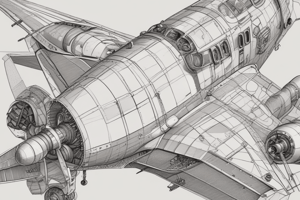Podcast
Questions and Answers
What type of fastener obtains its clamping action by having one of its ends mechanically upset?
What type of fastener obtains its clamping action by having one of its ends mechanically upset?
- Bolt
- Rivet (correct)
- Screw
- Nut
Which organization originated the standards identified by 'AN' specifications for aircraft hardware?
Which organization originated the standards identified by 'AN' specifications for aircraft hardware?
- National Aerospace Standard
- Army-Navy
- Military Standards
- Air Force-Navy (correct)
What type of rivet has been the single most commonly used aircraft fastener since sheet metal was first utilized in aircraft?
What type of rivet has been the single most commonly used aircraft fastener since sheet metal was first utilized in aircraft?
- Hi-lock Rivet
- Screw Rivet
- Solid-Shank Rivet (correct)
- Pop Rivet
What happens to a solid-shank rivet's cross-sectional area when it is driven into place?
What happens to a solid-shank rivet's cross-sectional area when it is driven into place?
Which specification is used when an 'MS20470-AD4-4' rivet is required?
Which specification is used when an 'MS20470-AD4-4' rivet is required?
Why do aircraft manufacturers use specifications and call for standard hardware in building aircraft?
Why do aircraft manufacturers use specifications and call for standard hardware in building aircraft?
Why do joints utilising countersunk rivets generally lack the strength of protruding-head rivet joints?
Why do joints utilising countersunk rivets generally lack the strength of protruding-head rivet joints?
What is the purpose of countersinking before installing countersunk rivets?
What is the purpose of countersinking before installing countersunk rivets?
Which process is used when sheet thickness and rivet size determine the best method for joining?
Which process is used when sheet thickness and rivet size determine the best method for joining?
What type of alloy are most aircraft rivets made of?
What type of alloy are most aircraft rivets made of?
How does dimpling differ from countersinking in preparing metal for riveting?
How does dimpling differ from countersinking in preparing metal for riveting?
Why were AN426 countersunk rivets developed primarily for aerofoils and control surfaces?
Why were AN426 countersunk rivets developed primarily for aerofoils and control surfaces?
Which type of rivet is designated by the letter A in the rivet code?
Which type of rivet is designated by the letter A in the rivet code?
What is the main advantage of using alloy 2117-T3 for rivets?
What is the main advantage of using alloy 2117-T3 for rivets?
What type of applications are 1100 aluminium rivets restricted to?
What type of applications are 1100 aluminium rivets restricted to?
Why are AD rivets often referred to as 'field rivets'?
Why are AD rivets often referred to as 'field rivets'?
What effect does coldworking have on the shear strength of 1100 aluminium rivets?
What effect does coldworking have on the shear strength of 1100 aluminium rivets?
What identifying feature do rivets made of aluminium alloy 2117-T3 have on their head?
What identifying feature do rivets made of aluminium alloy 2117-T3 have on their head?
What is the purpose of the lock ring on an Olympic-Lok blind fastener?
What is the purpose of the lock ring on an Olympic-Lok blind fastener?
What distinguishes Olympic-Lok rivets from other blind fasteners?
What distinguishes Olympic-Lok rivets from other blind fasteners?
What is a key feature of CherryMAX rivets that makes them cost-effective?
What is a key feature of CherryMAX rivets that makes them cost-effective?
In what diameters are CherryMAX rivets available?
In what diameters are CherryMAX rivets available?
What is the main purpose of the safe-lock locking collar on a CherryMAX rivet?
What is the main purpose of the safe-lock locking collar on a CherryMAX rivet?
Why are HuckLoks primarily used by aircraft manufacturers and large repair facilities?
Why are HuckLoks primarily used by aircraft manufacturers and large repair facilities?
What is the purpose of using special fasteners as opposed to standard AN nut-and-bolt assemblies?
What is the purpose of using special fasteners as opposed to standard AN nut-and-bolt assemblies?
Which material is NOT mentioned as an alloy in which Hi-Lok bolts are manufactured?
Which material is NOT mentioned as an alloy in which Hi-Lok bolts are manufactured?
What is used to install a Hi-Lok into a hole?
What is used to install a Hi-Lok into a hole?
How are Hi-Lok retaining collars typically tightened?
How are Hi-Lok retaining collars typically tightened?
What happens to the wrenching device after tightening the Hi-Lok retaining collar?
What happens to the wrenching device after tightening the Hi-Lok retaining collar?
Why do Hi-Loks not undergo the same tensile loads as standard AN bolts during installation?
Why do Hi-Loks not undergo the same tensile loads as standard AN bolts during installation?
Study Notes
Rivet Specifications and Standards
- Rivet specifications and standards for aircraft hardware are identified by the organisation originating them, such as AN (Air Force-Navy), NAS (National Aerospace Standard), and MS (Military Standards).
- These specifications stipulate the material to be used, as well as the rivet dimensions.
Solid-Shank Rivets
- Solid-shank rivets have been used since sheet metal was first utilised in aircraft and remain the single most commonly used aircraft fastener today.
- Unlike other types of fasteners, rivets change in dimension to fit the size of a hole.
- When a rivet is driven, its cross-sectional area increases along with its bearing and shearing strengths.
- Solid-shank rivets are available in a variety of materials, head designs, and sizes to accommodate different applications.
Rivet Head Design
- Countersunk rivets lack the strength of protruding-head rivet joints due to material being cut away to allow for the countersunk head, and potential lack of direct contact between the gusset and rivet head.
- AN426 countersunk rivets were developed to streamline aerofoils and permit a smooth flow over an aircraft’s wings or control surfaces.
- Countersinking is a process that cuts away metal in the shape of the rivet head, while dimpling mechanically ‘dents’ the sheets being joined to accommodate the rivet head.
Rivet Alloys
- Most aircraft rivets are made of aluminium alloy, identified by a letter in the rivet code and a mark on the rivet head.
- 1100 Aluminium (A) rivets are made of pure aluminium, lack sufficient strength for structural applications, and are restricted to non-structural assemblies.
- 2117 Aluminium Alloy (AD) rivets are the most widely used for manufacturing and maintenance of modern aircraft, have a dimple in the centre of the head, and are represented by the letters AD in the rivet part codes.
Hi-Lok and Blind Rivets
- Hi-Lok bolts are manufactured in several different alloys and possess sufficient strength to withstand bearing and shearing loads.
- Olympic-Lok blind fasteners are lightweight, mechanically locking spindle-type blind rivets with a lock ring that slips down the stem and locks the centre stem to the outer shell during installation.
- CherryMAX rivets are economical to use, strong enough to replace solid-shank rivets size for size, and are available in diameters of 1/8, 5/32, 3/16, and 1/4 in.
Studying That Suits You
Use AI to generate personalized quizzes and flashcards to suit your learning preferences.
Related Documents
Description
Test your knowledge on the specifications and standards for aircraft rivets, including common identifiers like AN, NAS, and MS. Understand how rivets work as fasteners and learn about specific rivet types like MS20470-AD4-4.




